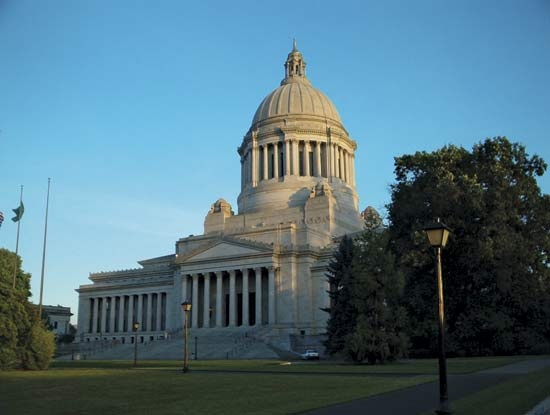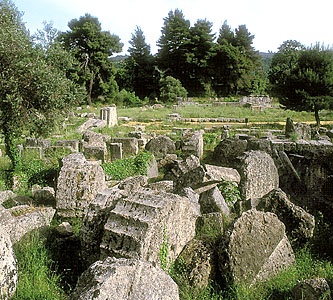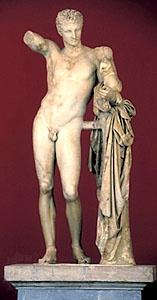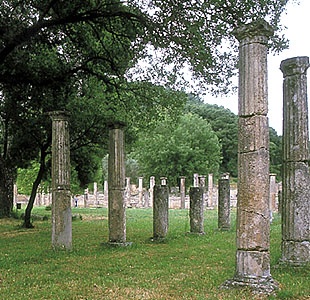Olympia
Washington, United States
 city, capital of Washington, U.S., seat (1852) of Thurston county, on Budd Inlet and Capitol Lake (at the south end of Puget Sound), at the mouth of the Deschutes River, 29 miles (47 km) southwest of Tacoma. Laid out in 1851 as Smithfield, it became the site of a U.S. customs house and was renamed for the nearby Olympic Mountains. Chosen as the territorial capital in 1853, Olympia developed port facilities and a lumber-based economy, augmented by oyster farming, dairying, brewing, and other industries. Its harbour serves as the base for a large merchant reserve fleet and contains a large mixed industrial complex capable of receiving seaborne container freight. The Old Capitol (built 1893) is used as a state office building. The Capitol Group (completed 1935) stands on a promontory in a 35-acre (14-hectare) park; the State Capitol Museum contains documents, photographs, and artifacts relating to Washington history. Located at the base of the Olympic Peninsula, the city is the gateway to Olympic National Park and is the headquarters for the Olympic National Forest. It is the home of Evergreen State College (1967), and nearby Lacey is the site of St. Martin's College (1895). The Nisqually National Wildlife Refuge, a wetlands area sheltering a variety of birds and marine mammals, lies to the east of the city. Inc. 1859. Pop. (2000) city, 42,514; Olympia MSA, 207,355; (2005 est.) city, 44,114; Olympia MSA, 228,881.
city, capital of Washington, U.S., seat (1852) of Thurston county, on Budd Inlet and Capitol Lake (at the south end of Puget Sound), at the mouth of the Deschutes River, 29 miles (47 km) southwest of Tacoma. Laid out in 1851 as Smithfield, it became the site of a U.S. customs house and was renamed for the nearby Olympic Mountains. Chosen as the territorial capital in 1853, Olympia developed port facilities and a lumber-based economy, augmented by oyster farming, dairying, brewing, and other industries. Its harbour serves as the base for a large merchant reserve fleet and contains a large mixed industrial complex capable of receiving seaborne container freight. The Old Capitol (built 1893) is used as a state office building. The Capitol Group (completed 1935) stands on a promontory in a 35-acre (14-hectare) park; the State Capitol Museum contains documents, photographs, and artifacts relating to Washington history. Located at the base of the Olympic Peninsula, the city is the gateway to Olympic National Park and is the headquarters for the Olympic National Forest. It is the home of Evergreen State College (1967), and nearby Lacey is the site of St. Martin's College (1895). The Nisqually National Wildlife Refuge, a wetlands area sheltering a variety of birds and marine mammals, lies to the east of the city. Inc. 1859. Pop. (2000) city, 42,514; Olympia MSA, 207,355; (2005 est.) city, 44,114; Olympia MSA, 228,881.ancient site, Greece
Introduction

ruined ancient sanctuary, home of the ancient Olympic Games, and former site of the massive Statue of Zeus (Zeus, Statue of), which had been ranked as one of the Seven Wonders of the World. Olympia is located near the western coast of the Peloponnese peninsula of southern Greece, 10 miles (16 km) inland from the Ionian Sea, near a point where the Alpheus (Alfios) (Alpheus River) and Cladeus (Kladios) rivers meet. Set amid an idyllic countryside consisting of low, wooded hills alternating with farmland, the Olympia archaeological site is of outstanding cultural significance. It was designated a UNESCO World Heritage site in 1989.
History and excavations
The earliest remains date from 2000 to 1600 BC, the sanctuary itself from about 1000. First controlled by the nearby town of Pisa, Olympia later came under the jurisdiction of Elis, which subjugated Pisa and Pisatis, the surrounding region, in 572 BC. The festival (Greek religion) of Zeus, of which the Olympic Games were a part, was held there every four years from 776 BC until the end of the 4th century AD, when the Roman emperor Theodosius I abolished pagan festivals. Theodosius II had the temples destroyed in 426; earthquakes further damaged the ruins in 522 and 551. Mudslides and silt from the Cladeus River eventually covered much of the area, helping to preserve the site.
The first excavations were conducted around the Temple of Zeus in 1829 by the French Expédition Scientifique de Morée, led by Abel Blouet. The temple was sufficiently cleared to reveal its general plan, and fragments of three sculptured metopes (panels) were found, which were later placed in the Louvre, in Paris. The great German excavations of 1875–81 (led by Ernst Curtius (Curtius, Ernst)) cleared the whole of the sacred precinct and some buildings that lay outside it, and the position of the stadium was located by exploratory trenches. Thus the plan of a great Greek sanctuary was revealed for the first time. In the early 20th century some small-scale exploratory digging was done in the deeper layers of the sanctuary. Large-scale work was resumed by German archaeologists in 1936, one of the chief aims being the excavation and restoration (art conservation and restoration) of the stadium. Interrupted in 1942 by the events of World War II, work was resumed in 1952, and in 1960 the excavation of the stadium was completed, with its restoration in 1961. Other structures were explored in this period, the most important of which was the atelier (workshop) of the master sculptor Phidias, who was the creator of the Statue of Zeus. In the late 20th century, research was conducted primarily by the German Archaeological Institute in Athens and the Ephorate (Magistrate) of Antiquities in Olympia. The Archaeological Museum at Olympia opened in its present location in 1982.
The remains
The sacred precinct, known as the Altis, or Sacred Grove of Zeus, was an irregular quadrangle more than 600 feet (183 metres) on a side, bounded on the north by the hill of Cronus and enclosed by a wall on the other three sides. In it were the temples of Zeus and Hera, the principal altars and votive offerings, the treasuries, and the administrative buildings. Outside were the athletic installations and the hostels, baths, and other accommodations for visitors.
 The Temple of Zeus was the largest and most important building at Olympia and one of the largest Doric temples in Greece. Built about 460 BC by the architect Libon of Elis, the temple was made of a coarse local shell conglomerate, the exposed surfaces being covered with a coat of fine white stucco. The temple had 6 columns across the front and 13 on the sides. Its pronaos (porch) and opisthodomos (rear porch) provided access to the lofty central hall, or cella, which was divided into three aisles by two rows of slender columns. The roof tiles were of marble.
The Temple of Zeus was the largest and most important building at Olympia and one of the largest Doric temples in Greece. Built about 460 BC by the architect Libon of Elis, the temple was made of a coarse local shell conglomerate, the exposed surfaces being covered with a coat of fine white stucco. The temple had 6 columns across the front and 13 on the sides. Its pronaos (porch) and opisthodomos (rear porch) provided access to the lofty central hall, or cella, which was divided into three aisles by two rows of slender columns. The roof tiles were of marble. The temple was richly decorated with sculpture, much of which has survived and may be seen in the Archaeological Museum. In the front gable the chariot race between Pelops and Oenomaus was represented, and both parties were shown preparing for the race. In the back gable was the battle of the Lapiths and Centaurs (Centaur) at the wedding of Pirithous. These sculptures are masterpieces of the early Classical style, but the name of the artist is not known. The geographer Pausanias' attribution of the sculptures to Paeonius and Alcamenes is generally rejected because these sculptors are known to have worked in the later 5th century BC. The frieze that ran above the front and back porches had sculptured metopes with the Twelve Labours of Heracles, six at each end. At the peak of the pediment (triangular gable) was a gilded figure of Victory and at each corner a gilded cauldron, but these have not survived.
The temple was richly decorated with sculpture, much of which has survived and may be seen in the Archaeological Museum. In the front gable the chariot race between Pelops and Oenomaus was represented, and both parties were shown preparing for the race. In the back gable was the battle of the Lapiths and Centaurs (Centaur) at the wedding of Pirithous. These sculptures are masterpieces of the early Classical style, but the name of the artist is not known. The geographer Pausanias' attribution of the sculptures to Paeonius and Alcamenes is generally rejected because these sculptors are known to have worked in the later 5th century BC. The frieze that ran above the front and back porches had sculptured metopes with the Twelve Labours of Heracles, six at each end. At the peak of the pediment (triangular gable) was a gilded figure of Victory and at each corner a gilded cauldron, but these have not survived.Within the temple was the great gold and ivory (chryselephantine) Statue of Zeus (Zeus, Statue of), one of the masterworks of the Athenian sculptor Phidias and the most famous of all ancient statues. It made a profound impression on all who saw it, and people generally agreed that Phidias had succeeded in creating the image of Homer's Zeus. The god was represented seated on an elaborately wrought throne. He held a figure of the goddess of victory ( Nike) in his right hand and a sceptre in his left.
The statue (which was destroyed sometime in the 5th century AD) was nearly 40 feet (12 metres) high and was made piece by piece by Phidias and his collaborators in a building just outside the Altis to the west of the temple. Subsequently converted into a church, the building was still known in the time of Pausanias (2nd century AD) as the “workshop of Phidias.” The excavations of 1954–58 brought dramatic confirmation of the identification. In the deep layers in and around the building, particularly toward the south, a great mass of waste material from the artist's atelier was found. This material included tools, slivers and worked fragments of ivory and bone, glass ornaments, and molds. The clay molds are of a very heavy fabric, like roof tiles, with the larger ones sometimes reinforced with iron rods. The molds were evidently used for hammering into shape the thin sheets of gold that formed the statue's drapery. Pottery found with this debris indicates that the workshop was active in the years around 430 BC; this discovery settled an old controversy as to whether Phidias made the Zeus before or after his other great chryselephantine statue, the Athena Parthenos, which was placed in the Parthenon in 438 BC. One of the pieces of pottery, a ribbed mug, has inscribed on its bottom in neat clear letters the words “I am 【the property】 of Phidias.”
 The great altar of Olympian Zeus was not in the front of the temple, as might have been expected, but to one side and nearer the Heraion, or Temple of Hera. The altar was elliptical in shape and consisted of an elevated base approached by steps. From the base rose a large mound made of the ashes of the thighs of animal victims sacrificed to Zeus. The total height of the altar was 22 feet (6.7 metres).
The great altar of Olympian Zeus was not in the front of the temple, as might have been expected, but to one side and nearer the Heraion, or Temple of Hera. The altar was elliptical in shape and consisted of an elevated base approached by steps. From the base rose a large mound made of the ashes of the thighs of animal victims sacrificed to Zeus. The total height of the altar was 22 feet (6.7 metres). The oldest temple at Olympia and one of the most venerable in all Greece was that of Hera (Heraeum), originally a joint temple of Hera and Zeus until a separate temple was built for him. It has sometimes been thought that the Heraion was built in the 11th or 10th century BC, but this view is now rejected. The existing temple, the most intact structure in Olympia, was probably built about 600 BC, and an earlier phase, without peristyle (colonnade), may date to the 8th century. The temple is long and narrow, having 6 Doric columns across the ends and 16 along the sides. The columns show a great variety of styles because they were originally of wood and were gradually replaced in stone. In the 2nd century AD there was still one wooden column in the opisthodomos. The entablature was of wood, and the upper parts of the walls were of mud brick. The cella had two interior rows of columns, alternate columns being attached by spurs to the cella walls and thus forming bays. Pausanias wrote that in the temple was an image of Hera seated on a throne with an image of Zeus standing beside her, and during excavations an archaic limestone head thought to be that of Hera was found. Pausanias also reported the existence of a stone statue of Hermes carrying the young Dionysus; this work of the great sculptor Praxiteles was found in the cella of the temple in 1877 and is one of the most prized possessions of the Archaeological Museum at Olympia.
The oldest temple at Olympia and one of the most venerable in all Greece was that of Hera (Heraeum), originally a joint temple of Hera and Zeus until a separate temple was built for him. It has sometimes been thought that the Heraion was built in the 11th or 10th century BC, but this view is now rejected. The existing temple, the most intact structure in Olympia, was probably built about 600 BC, and an earlier phase, without peristyle (colonnade), may date to the 8th century. The temple is long and narrow, having 6 Doric columns across the ends and 16 along the sides. The columns show a great variety of styles because they were originally of wood and were gradually replaced in stone. In the 2nd century AD there was still one wooden column in the opisthodomos. The entablature was of wood, and the upper parts of the walls were of mud brick. The cella had two interior rows of columns, alternate columns being attached by spurs to the cella walls and thus forming bays. Pausanias wrote that in the temple was an image of Hera seated on a throne with an image of Zeus standing beside her, and during excavations an archaic limestone head thought to be that of Hera was found. Pausanias also reported the existence of a stone statue of Hermes carrying the young Dionysus; this work of the great sculptor Praxiteles was found in the cella of the temple in 1877 and is one of the most prized possessions of the Archaeological Museum at Olympia.A row of 12 treasuries overlooked the Altis from the lowest slopes of the hill of Cronus. These small structures in the form of Doric temples date from the 6th century BC. All were erected by Dorian states ranging from Byzantium to Gela in Sicily and Cyrene in northern Africa. In the case of only three—Sicyon, Megara, and Gela—is enough material available to allow a reconstruction on paper. These treasuries were erected by the several states either as thanksgiving offerings for Olympic victories or as a general mark of homage to Olympian Zeus. The structures also contained great fortunes in dedicated gifts.
Between the temples of Zeus and Hera in the Altis stood a sanctuary (the Pelopion) dedicated to the Elean hero Pelops. It was open to the sky and surrounded by a wall, with trees and statues within.
The Metroum, or Temple of the Great Mother of the Gods, was a small Doric temple of the 4th century BC just below the treasuries. Because the cult no longer existed in Roman times, the temple became used for the display of statues of Roman emperors.
The Philippeum, a circular building of the Ionic order, with Corinthian half columns on the inside, was begun by Philip II (Philip of Macedon) (Philip II) and probably finished by his son, Alexander the Great. Containing gold and ivory statues of Philip, Alexander, and other members of the family, it commemorated Philip's victory over the Greeks at Chaeronea in 338 BC.
The prytaneum, a building in the northwest corner of the Altis, contained a hearth on which burned a “perpetual fire”; it also had a banquet room in which the Olympic victors were feasted. The Exedra of Herodes Atticus is a large, lavishly decorated fountain, on an apsidal (semicircular) plan; erected by the orator Herodes Atticus in the name of his wife Regilla, it stored drinking water brought into Olympia by an aqueduct 2 miles (3.2 km) long. On it were displayed some 20 statues of Herodes and his family and of the Roman emperors Hadrian and Antoninus Pius.
The Echo Colonnade was officially called the Stoa Poikile, or Painted Colonnade, from the paintings that used to be on its walls. It received its popular name because a word uttered there was echoed seven times or more. The colonnade closed the east side of the Altis and was separated from the east Altis wall, which supported the stadium embankment, by a narrow passage. The colonnade was built soon after the middle of the 4th century BC. Deep beneath its floor, excavators found the starting line of the early classical stadium.
The Bouleuterion, or council house, was the seat of the Olympic Senate. Lying just outside the Altis to the south, it was composed of two Doric buildings of different date but of identical oblong form with apsidal ends toward the west. In the rectangular court between the two buildings was a statue of Zeus Horkios (“Zeus Who Presides over Oaths”). Beside this statue the athletes took an oath not to indulge in foul play during the contests.
 Southwest of the Altis stood the Leonidaeum, a large hostel for the reception of distinguished visitors, which was built in the 4th century BC and remodeled in Roman times. To the northwest were the Palaestra, where wrestlers and boxers trained, and the gymnasium, which included an elaborate entrance gateway and a covered running track.
Southwest of the Altis stood the Leonidaeum, a large hostel for the reception of distinguished visitors, which was built in the 4th century BC and remodeled in Roman times. To the northwest were the Palaestra, where wrestlers and boxers trained, and the gymnasium, which included an elaborate entrance gateway and a covered running track.The stadium lay to the east of the Altis. In early classical times it was not cut off from the sanctuary, and one end of the track was directly in front of the great ash altar of Zeus (beneath the later Echo Colonnade). About the mid-4th century BC the stadium was shifted some 270 feet (82 metres) eastward. The track was surrounded by massive sloping embankments of earth for the accommodation of the spectators (some 40,000), except to the north where the natural slope of the hill sufficed. The western embankment, parallel to which the Echo Colonnade was built, effectively cut the stadium off from the Altis. Connection between the two areas was maintained by what was called the Krypte, or Covered Entrance, which pierced the embankment and, in Roman times, was covered with a stone vault. This entrance was used by the athletes and the umpires. Just outside the Krypte stood bronze statues of Zeus, called Zanes; they were erected with money from fines imposed on those who violated the rules of the Games. The bases of 16 of these statues have been excavated.
The only stone seats in the stadium were located in a box on the south side, about one-third of the way from the starting line nearest the Altis; there sat the hellanodikai, the chief judges of the Games. Directly opposite the box was the altar of Demeter Chamyne, from which the priestess of that cult was privileged to watch the Games (sources generally agree that other women were excluded from the festival). The track area was about 690 feet (210 metres) long and 105 feet (32 metres) wide and separated from the sloping embankments by a low stone parapet beside which ran an open stone water channel with basins at intervals. The stone starting lines at either end of the actual course are still in place, lying about 630 feet (192 metres) apart. There was space for 20 runners at a time. The classic race was the stade—i.e., one length of the course. There was also a diaulos, two lengths, and a dolichos, or long-distance race, the length of which varied and might have been as much as 24 stades, or nearly 3 miles (4.8 km). Other athletic contests were also held in the 4th-century stadium, which has been fully excavated and its track and embankments restored.
When the stadium embankments were excavated, many votive offerings were discovered. Some of these were works of art, including bronze statuettes and reliefs and several terra-cotta statues, of which the most noteworthy was a group of Zeus and Ganymede, about half-life-size and dating from about 470 BC. Other notable votive offerings were arms or armour that had been dedicated in the sanctuary. The Archaeological Museum houses these findings, which constitute the largest collection of ancient Greek weapons in the world. Some of the weapons have identifying inscriptions that are interesting historical documents, such as a Persian helmet marked with the phrase “The Athenians 【dedicated the helmet】 to Zeus, having taken it from the Medes.”
The hippodrome lay south of the stadium in the open valley of the Alpheus River. Pausanias gives a long description of the hippodrome and of the elaborate machinery used to start the horse races.
Additional Reading
J.G. Frazer, Pausanias's Description of Greece, trans. with commentary (1913), is the story of the Greek traveler Pausanias, who visited Olympia in the 2nd century AD and detailed the place in his books v and vi. Frazer's commentary is thorough and makes full use of modern knowledge of Olympia gained from the original German excavations. E. Norman Gardiner, Olympia: Its History and Remains (1925), is a good general account. Ludwig Drees, Olympia: Götter, Künstler und Athleten (1967; Olympia: Gods, Artists and Athletes, 1968), is richly illustrated, with sections on the religious festival, the Olympic Games, and the buildings. See also Bernard Ashimole and Nicholas Yalouris, Olympia: The Sculptures of the Temple of Zeus, with photographs by Alison Frantz (1967).
- Herbert Charles Brown
- Herbert David Croly
- Herbert, Edward Herbert, 1st Baron
- Herbert Eugene Bolton
- Herbert, Frank
- Herbert, George
- Herbert Hall Turner
- Herbert Harold Read
- Herbert H. Dow
- Herbert Hoover
- Herbert Hoover: Against the Proposed New Deal
- Herbert Hoover: Inaugural Address
- Herbert Hoover: Moral Standards in an Industrial Era
- Herbert Hoover: The New Deal and European Collectivism
- Herbert John Gladstone, 1st Viscount Gladstone
- Herbert John Gladstone Gladstone, 1st Viscount
- Herbert Kroemer
- Herbert Lars Gustaf Tingsten
- Herbert Louis Samuel, 1st Viscount Samuel
- Herbert Louis Samuel Samuel, 1st Viscount
- Herbert Marcuse
- Herbert Matter
- Herbert Osborne Yardley
- Herbert Putnam
- Herbert River